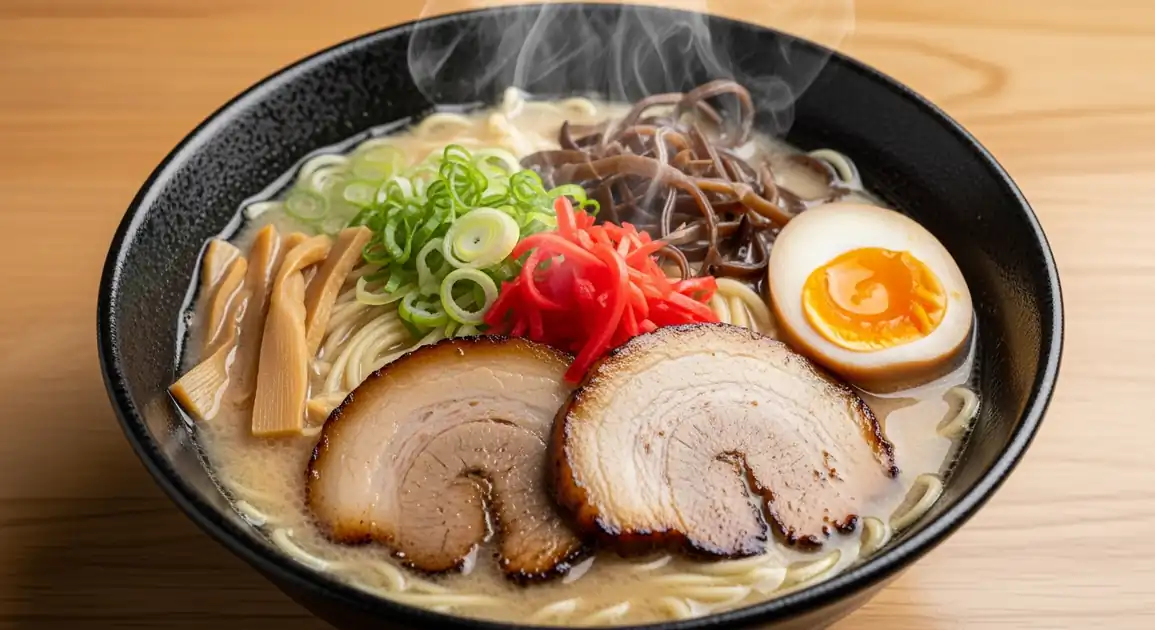Hakata Ramen
博多ラーメン

Description
Fukuoka is the birthplace and undisputed home of Hakata Ramen. The city offers an incredible density and variety of Hakata Ramen experiences, from legendary long-standing shops and famous chains (Ichiran, Ippudo started here) to countless smaller neighborhood joints and the unique 'yatai' (open-air food stalls) culture, especially vibrant in areas like Nakasu and Tenjin.
Dietary Information
Serving information
Serving style
Classic Hakata style: hot tonkotsu broth, thin straight noodles, simple toppings, kaedama system, counter condiments (beni shoga, karashi takana, sesame, garlic). Served immediately after preparation.
Quick facts
Shops: Often 11 AM - 10 PM or later, some 24 hours (Ichiran). Yatai: Typically 6 PM/7 PM - 1 AM/2 AM (weather dependent, often closed one day a week).
Safety Tips
What to Look For
-
Shop/Stall Cleanliness
Check counters, floors, condiment containers, and staff hygiene. Yatai cleanliness is particularly important to observe.
-
Steaming Hot Broth
The broth should be served very hot, indicating it's freshly prepared and held at a safe temperature. This helps cook toppings like raw garlic if added.
-
High Customer Turnover
Especially for yatai, busy stalls mean ingredients are likely fresh and broth is constantly replenished/reheated.
-
Fresh Looking Toppings
Ensure toppings like chashu, negi, and eggs look fresh and are stored properly (e.g., refrigerated if prepared ahead).
-
Noodles Cooked to Order
Noodles are always cooked fresh for each bowl, ensuring proper texture and temperature.
What to avoid
-
Dirty or Poorly Maintained Shop/Yatai
Obvious lack of cleanliness in the eating area, kitchen, or around condiment station is a major red flag.
-
Lukewarm Broth
Broth served insufficiently hot may not be safe and indicates poor handling or preparation.
-
Old or Discolored Toppings
Avoid places where toppings (especially pork or egg) look dried out, discolored, or improperly stored.
-
Unpleasant Broth Smell
While tonkotsu has a distinct pork aroma, it shouldn't smell sour, rancid, or overly 'funky', which could indicate spoilage.
-
Visible Pests or Poor Waste Management
Presence of flies, rodents, or overflowing bins near the stall/shop suggests significant hygiene issues.
Price information
Price range
Budget tips
- Basic bowls at local shops or yatai can be found for 700-900 JPY.
- Famous chain restaurants might be slightly more expensive (900-1200 JPY for a standard bowl).
- Kaedama typically costs 100-150 JPY.
- Lunch sets might offer better value.
Value indicators
- Authentic rich tonkotsu broth (look for the distinct aroma near shops).
- Properly cooked thin noodles (firmness options available).
- Presence of classic toppings: chashu, negi, maybe kikurage.
- Availability of condiments like beni shoga, karashi takana, sesame.
- Popularity with locals, especially outside peak tourist hours.
Where to Find This Dish
Nakasu
Famous for its lively 'yatai' (food stall) scene lining the river, many serving Hakata Ramen alongside other street foods like yakitori.
Naka River, Fukuhaku Deai Bridge
Evening, Late Night (7 PM onwards)
Tenjin
Fukuoka's downtown shopping and entertainment hub, hosting numerous ramen shops from famous chains to local favorites, plus some yatai.
Tenjin Station, Solaria Plaza, IMS Building
Lunch, Dinner, Late Night
Hakata Station Area
Many ramen shops located in and around the main train station, including 'Ramen Street' ('Deitos Annex').
Hakata Station, Deitos, Canal City Hakata (nearby, has Ramen Stadium)
Lunch, Dinner
Nagahama
The Nagahama Fish Market area is historically linked to ramen (Nagahama Ramen). Fewer stalls now, but some iconic shops remain.
Nagahama Fish Market
Very Early Morning (historically), Lunch, Evening
Vendor Tips
- Be prepared for queues at famous shops (Ichiran, Ippudo flagships, Shin-Shin etc.).
- Explore different shops; many excellent but lesser-known places exist.
- Yatai offer great atmosphere but choose carefully based on cleanliness and crowd. Be aware some yatai have seating charges ('sekiryō').
- Don't miss trying 'karashi takana' (spicy mustard greens) as a condiment, but add sparingly at first.
- Ask locals for their personal recommendations ('osusume no ramen-ya wa?').
How to Order
Regional Variations
-
Yatai Ramen
(屋台ラーメン)
Hakata Ramen served at a yatai stall. The ramen itself is usually classic Hakata style, but the experience and atmosphere are distinct.
-
Nagahama Ramen
(長浜ラーメン)
Very similar to Hakata Ramen, sometimes lighter, served near the Nagahama fish market. Often associated with the origin of Kaedama.
-
Shop-Specific Broths
(店独自のスープ)
While adhering to tonkotsu principles, each shop has its own secret recipe and technique, leading to subtle variations in richness, saltiness, and aroma.
-
Spicy Variations
(辛いラーメン)
Some shops offer versions with added spice, like incorporating spicy miso or chili oil.
Cultural context
History
Originating in the Hakata district of Fukuoka city on Kyushu island after World War II, Hakata Ramen evolved from Chinese noodle soups. It was initially developed as quick, affordable, and filling food for workers at the fish market, served from 'yatai' (food stalls). The use of pork bones, readily available and cheap, defined its unique 'tonkotsu' broth. Its popularity spread nationally and globally, with famous chains like Ichiran and Ippudo originating from Hakata.
Local significance
Hakata Ramen is Fukuoka's soul food, deeply ingrained in the city's identity and culinary landscape. It's a source of local pride.
Eating customs
- Quick eating is common.
- Slurping is expected.
- Utilizing the counter condiments (beni shoga, takana, sesame) is encouraged.
- Yatai etiquette involves ordering at least one dish/drink per person and not staying excessively long if crowded.